
Chapter 17: The Microorganisms Viruses, Bacteria, and Protists
17.1 The Viruses
Viruses have not been classified as living historically.
The classification of viruses as living or not is still debated among biologists.
Viruses possess a genome consisting of a few hundred genes.
Viruses use the host cell to manufacture new viruses.
The origins of viruses are unclear.
Some research suggests that viruses may be remnants of bacteria.
Viruses have played an important role in the evolution of life on the planet.
The debate over whether viruses are living or not continues in the scientific community.
Structure of a Virus
Each type of virus has at least two parts: an outer capsid and an inner core.
The outer capsid is composed of protein subunits.
The inner core contains genetic material, which may be DNA or RNA.
The influenza virus has spikes formed from a glycoprotein, which are involved in attaching the virus to the host cell.
Influenza viruses have two types of spikes, and the variations in their structure give each type of influenza virus its name.
Some viruses that attack animals have an outer membranous envelope with glycoprotein spikes.
The envelope is a piece of the host's plasma membrane, which also contains proteins produced by the virus.
The interior of a virus can contain various enzymes that assist in the manufacture of new viruses.
The viral genome may be either DNA or RNA, but it has at most several hundred genes, while a human cell contains around 23,000 genes.
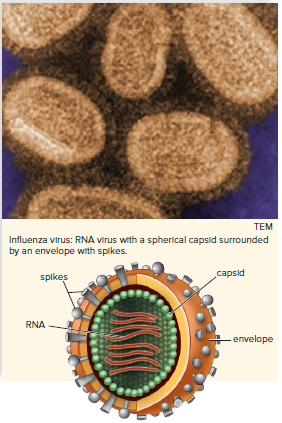
Viral Reproduction
Viruses need to attach to a specific molecule called a receptor on the host cell's outer surface to infect it.
The attachment is in a lock-and-key manner, where a spike or some portion of the capsid adheres to the receptor.
A virus cannot infect a host cell if it is unable to attach to it.
The tobacco mosaic virus cannot infect humans because its capsid cannot attach to the receptors on human cells.
Once inside a host cell, the virus takes over the metabolic machinery of the host cell.
The virus uses the host's enzymes, ribosomes, transfer RNA (tRNA), and ATP to reproduce itself.
Reproduction of Bacteriophages
A bacteriophage is a virus that reproduces in a bacterium.
Phages are often used as model systems for the study of viral reproduction.
Phage lambda (λ) is a type of bacteriophage.
Phage λ can reproduce via the lytic cycle or the lysogenic cycle.
The lytic cycle has five stages: attachment, penetration, biosynthesis, maturation, and release.
During attachment, the capsid combines with a receptor in the bacterial cell wall.
During penetration, a viral enzyme digests away part of the cell wall, and viral DNA is injected into the bacterial cell.
Biosynthesis of viral components begins after the virus inactivates host genes not necessary for viral replication.
During maturation, viral DNA and capsids assemble to produce several hundred viral particles.
Lysozyme, an enzyme coded for by a viral gene, disrupts the cell wall, and the release of phage particles occurs.
The lysogenic cycle involves the infected bacterium not immediately producing phages.
Following attachment and penetration, integration occurs: Viral DNA becomes incorporated into bacterial DNA with no destruction of host DNA.
While latent, the viral DNA is called a prophage.
The prophage is replicated along with the host DNA, and all subsequent cells, called lysogenic cells, carry a copy of the prophage.
Certain environmental factors, such as ultraviolet radiation, can induce the prophage to enter the lytic stage of biosynthesis, followed by maturation and release.
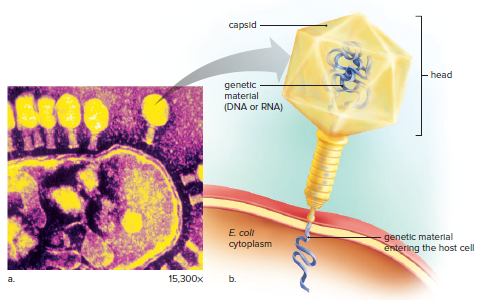
Plant Viruses
Crops and garden plants can be infected by viruses.
Plant viruses enter through damaged tissues and move through plasmodesmata.
The tobacco mosaic virus is a well-studied plant virus with a long, rod-shaped structure.
Plant viruses can be transmitted by insects, gardening tools, seeds, and pollen.
Viral diseases cannot be controlled by chemicals.
Symptomatic plants must be destroyed and insect vectors controlled to deal with viral diseases.
Biotechnology and genetic engineering can transfer disease-resistant genes between plants.
Papaya plants resistant to papaya ring spot virus (PRSV) have been created in Hawaii using genetic engineering.
One transgenic line of papaya plants is now completely resistant to PRSV.
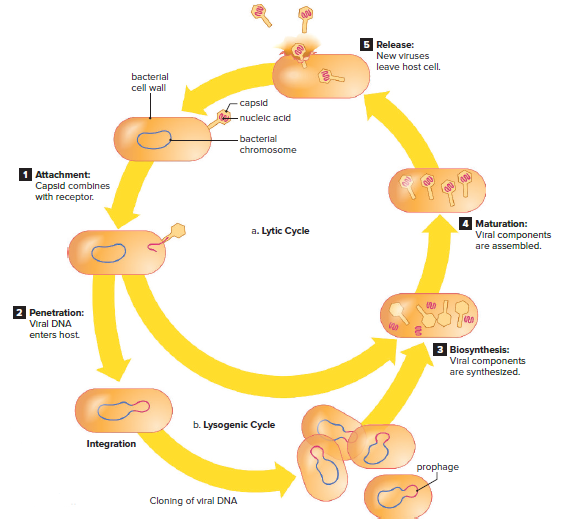
Animal Viruses
Viruses that cause disease in animals, including humans, reproduce similarly to bacteriophages.
Some animal viruses have an outer membranous envelope beyond their capsid.
Enveloped viruses either fuse with the plasma membrane or enter the host cell by endocytosis after attachment to a receptor in the plasma membrane.
The general life cycle of an animal virus involves uncoating, biosynthesis, maturation, and release.
Naked animal viruses exit the host cell in the same manner as bacteriophages, while animal viruses with an envelope bud from the cell.
Herpesviruses remain latent in the spinal ganglia until stimulated to undergo the lytic cycle.
HIV remains relatively latent in lymphocytes, slowly releasing new viruses.
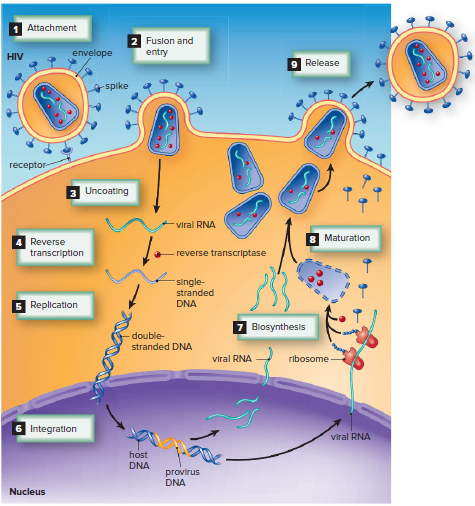
Retroviruses
Retroviruses use RNA as their genetic material.
Retroviruses contain an enzyme called reverse transcriptase.
Reverse transcriptase transcribes RNA to DNA.
One strand of DNA is synthesized using viral RNA as a template.
A complementary DNA strand is synthesized.
The resulting double-stranded DNA is integrated into the host genome.
Viral DNA remains in the host genome and is replicated with host DNA.
When transcribed, new viruses are produced through biosynthesis, maturation, and release.
HIV is an animal virus with an envelope.
HIV buds from the cell.
Emerging Viruses
HIV is an emerging virus that causes a disease that has recently infected large numbers of people.
Other examples of emerging viruses include West Nile virus, SARS virus, hantavirus, and avian influenza (H5N1) virus.
Infectious diseases emerge in several different ways, including the transportation of the virus from one location to another.
West Nile virus is an emerging virus because it changed its range and was transported into the United States, taking hold in bird and mosquito populations.
SARS was transported from Asia to Toronto, Canada.
Viruses are well known for their high mutation rates, and some mutations affect the structure of the spikes or capsids, allowing a virus that previously infected only a particular animal species to infect humans.
Examples of this include the viruses that cause AIDS and Ebola fever, which at one time infected only monkeys and apes.
MERS is a coronavirus that causes respiratory problems like shortness of breath, coughing, and fever.
MERS is a novel class of coronavirus that was not previously detected in humans.
Wild ducks are resistant to avian influenza viruses that can spread from them to chickens.
This increases the likelihood of the disease spreading to humans.
H5N1 is a virus that may change its mode of transmission from contact to airborne, which could increase the number of people exposed to bird flu.
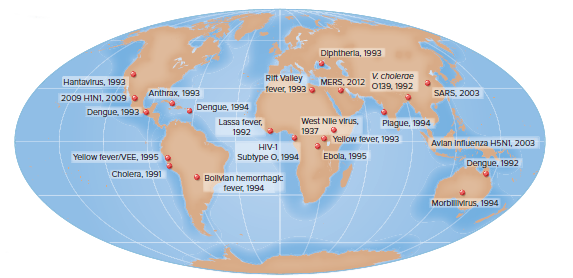
Drug Control of Human Viral Diseases
Antibiotics are ineffective against viruses as they only target living bacterial cells.
Viral infections were historically treated by allowing the immune system to use an adaptive immunity response.
Immunization is effective in preventing specific viral infections.
Antiviral drugs target specific aspects of the viral life cycle.
Antiviral compounds such as ribavirin and acyclovir interfere with viral genome synthesis.
Compounds related to acyclovir are used to suppress herpes outbreaks.
HIV is treated with antiviral compounds specific to the retrovirus.
AZT and other drugs block reverse transcriptase in HIV.
HIV protease inhibitors block enzymes required for viral protein maturation.
17.2 Viroids and Prions
About a dozen crop diseases are caused by viroids, which are naked RNA strands.
Viroids direct host cells to produce more viroids.
Viroids can cause unhealthy host plants and alter their physical characteristics.
Prions are proteinaceous infectious particles.
Prions cause kuru, a neurodegenerative disorder in a primitive tribe in Papua New Guinea.
Prions are smaller than viruses and are misshapen proteins.
Prions can interact with normal proteins, causing them to change shape and act as infectious agents.
Prion diseases include scrapie in sheep, mad cow disease, Creutzfeldt-Jakob disease in humans, and chronic wasting syndromes in other animal species.
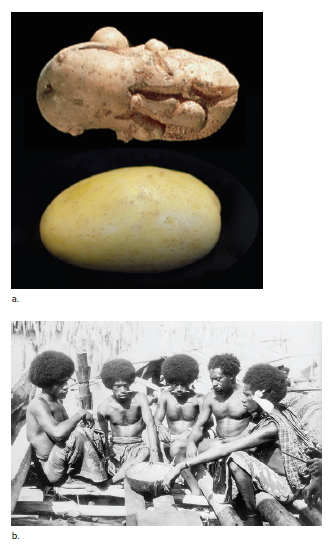
17.3 The Prokaryotes
The study of prokaryotes provides answers to questions about the first life on Earth and the most primitive features in modern cells.
Prokaryotes are single-celled organisms that lack a nucleus and internal organelle structures found in eukaryotes.
Some prokaryotes have internal membranes that perform similar functions to organelles.
Prokaryotes can be metabolically complex and can survive in extreme environments.
Prokaryotes are one of the dominant life forms on Earth in terms of numbers and biomass.
The Origin of the First Cells
Until the 19th century, many believed that prokaryotes could arise spontaneously.
Louis Pasteur showed in 1850 that previously sterilized broth cannot become cloudy with growth unless it is exposed directly to the air where bacteria are abundant.
The cell theory formulated around this time states that all organisms are composed of cells, cells are capable of self-reproduction, and cells come only from preexisting cells.
The first living cells were prokaryotes, possessing DNA but lacking a nucleus.
Fossilized prokaryotes have been found in rocks that are 3.5 billion years old.
The first cells were preceded by biological macromolecules, such as proteins and nucleic acids.
Amino acids, nucleotides, and other building blocks for biological macromolecules are routinely produced by living cells; this process is known as biotic synthesis.
Prior to cellular life, macromolecules must have formed by abiotic synthesis.
Stanley Miller conducted an experiment in the 1950s that indicated it was possible to form amino acids under the conditions that existed on the early Earth.
Protocells, cell-like structures complete with an outer membrane, may have resulted from the self-assembly of macromolecules and eventually given rise to cellular life.
Some researchers think the first hereditary molecule may have been RNA.
Over time, the more stable DNA replaced RNA as a long-term repository for genetic information, leading to the self-replicating system seen in all living cells today.
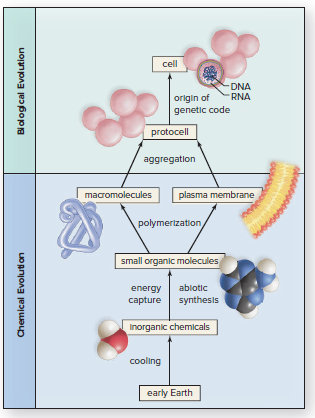
Bacteria
Bacteria are the most diverse and prevalent organisms on Earth.
Billions of bacteria exist in nearly every square meter of soil, water, and air.
Bacteria also inhabit our skin and intestines.
Tens of thousands of different bacteria have been identified, but they likely represent only a small fraction of the total number of bacterial species on the planet.
Less than 1% of bacteria in the soil can be grown in the laboratory.
Molecular genetic techniques are being used to discover the extent of bacterial diversity.
General Biology of Bacteria
Bacteria have various shapes, including cocci (spheres), bacilli (rods), spirilla (rigid spirals), and spirochetes (flexible spirals).
Some variations in bacterial shape include vibrios (slightly curved rods), doublets, chains (such as streptococci), and bunches of grapes (such as staphylococci).
Bacteria lack a nucleus but have a single, closed circle of double-stranded DNA called the chromosome, which occurs in the nucleoid.
Bacterial cells may also contain extrachromosomal DNA molecules called plasmids.
Bacteria have ribosomes but lack membrane-bound organelles like mitochondria and chloroplasts.
Some bacteria have internal folds of membranes that contain enzymes for cellular functions, such as thylakoid membranes in photosynthetic bacteria.
Motile bacteria use flagella for locomotion, which have a filament composed of three strands of the protein flagellin wound in a helix and are anchored in the plasma membrane by a basal body.
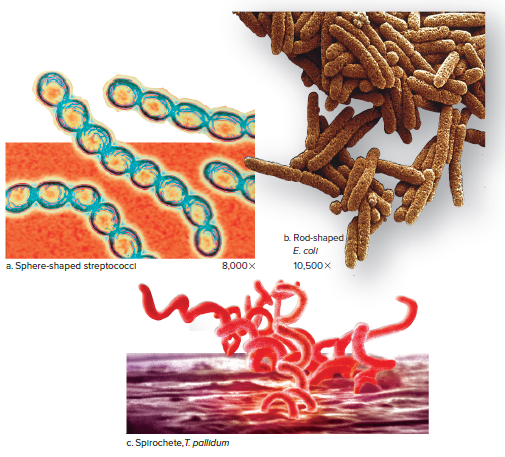
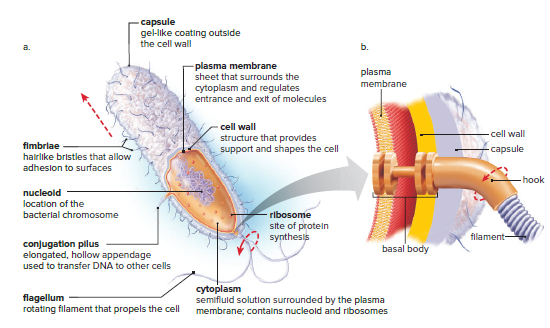
Bacterial Structure
Bacteria have a variety of shapes, including cocci (spheres), bacilli (rods), spirilla (rigid spirals), and spirochetes (flexible spirals).
Some variations in bacterial shape include vibrios (slightly curved rods), doublets, chains, and bunches of grapes.
Bacteria have no nucleus, and a single, closed circle of double-stranded DNA constitutes the chromosome, which occurs in an area of the cell called the nucleoid.
Bacteria have ribosomes but not membrane-bound organelles, such as mitochondria and chloroplasts.
Some bacteria have internal folds of membranes, which contain enzymes for cellular functions.
Motile bacteria generally use flagella for locomotion, which is not structured like a eukaryotic flagellum.
Bacterial Reproduction
Bacteria reproduce asexually by binary fission.
The single, circular chromosome replicates, and then the two copies separate as the cell enlarges.
The newly formed plasma membrane and cell wall partition the two new cells, with a chromosome in each one.
Mitosis does not occur in prokaryotes.
Eukaryotes undergo genetic recombination through sexual reproduction.
Prokaryotes do not undergo sexual reproduction.
Three means of genetic recombination have been observed in bacteria.
Conjugation is one of the three means of genetic recombination in bacteria.
During conjugation, a donor cell passes DNA directly to a recipient cell.
The donor and recipient cells are temporarily linked together during conjugation.
The conjugation pilus is often used to link the donor and recipient cells.
DNA is passed from the donor cell to the recipient cell while they are linked.
Transformation: Bacteria can take up free DNA from the environment. This DNA can come from dead bacteria or from other living bacteria.
Transduction: Bacteriophages, which are viruses that infect bacteria, can carry portions of bacterial DNA from one cell to another.
Endospores: Under unfavorable environmental conditions, some bacteria can form endospores. Endospores are dormant, highly resistant structures that can survive harsh conditions for extended periods of time. When conditions improve, endospores can germinate and produce new bacteria.
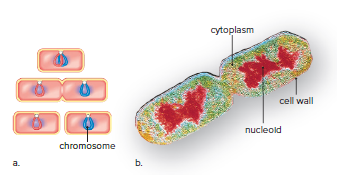
Prokaryotes are more metabolically diverse than eukaryotes.
Plants are photoautotrophs that perform oxygenic photosynthesis.
Cyanobacteria are an example of photosynthetic bacteria and may represent the oldest lineage of oxygenic organisms.
Cyanobacteria drastically altered the atmosphere of the early Earth by adding vast amounts of oxygen.
Many cyanobacteria are capable of fixing atmospheric nitrogen and reducing it to an organic form.
Other bacterial photosynthesizers don’t release oxygen because they take electrons from a source other than water.
Chemoautotrophs don’t use solar energy at all and reduce carbon dioxide using energetic electrons derived from inorganic molecules.
Most bacteria are chemoheterotrophs that take in organic nutrients, which they use as a source of energy and as building blocks to synthesize macromolecules.
Chemoheterotrophic bacteria are saprotrophs that send enzymes into the environment and decompose almost any large organic molecule into smaller ones that are absorbable.
Bacteria play a critical role in recycling matter and making inorganic molecules available to photosynthesizers.
Heterotrophic bacteria can be free-living or symbiotic.
Symbiotic relationships can be mutualistic, commensalistic, or parasitic.
Mutualistic bacteria in human intestines release vitamins K and B12.
Mutualistic prokaryotes in cow and goat stomachs digest cellulose.
Commensalism occurs when one population modifies the environment for the benefit of another.
Obligate anaerobes can live in our intestines because E. coli uses up oxygen.
Parasitic bacteria cause diseases.
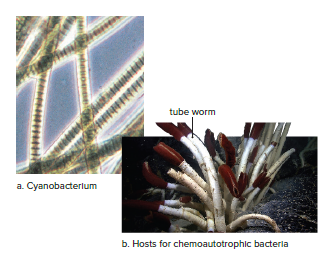
Environmental and Medical Importance of Bacteria
Bacteria play a crucial role in the cycling of elements in an ecosystem.
They are decomposers that digest dead organic remains and return inorganic nutrients to producers.
Bacteria perform the reactions needed for biogeochemical cyclings, such as for the carbon and nitrogen cycles.
Plants are unable to fix atmospheric nitrogen, but bacteria in the soil can fix atmospheric nitrogen and/or change nitrogen compounds into forms that plants can use.
Mutualistic bacteria live in the root nodules of soybean, clover, and alfalfa plants, where they reduce atmospheric nitrogen to ammonia, which is used by plants.
Bioremediation is the biological cleanup of an environment that contains harmful chemicals called pollutants.
Bacteria are being exploited to break down almost any substance, including sewage, pesticides, herbicides, detergents, and plastics.
Strains of bacteria are being developed specifically for digesting these types of pollutants.
Genetically modified bacteria can break the carbon-carbon bonds within oil spills, but their effectiveness is based on weather conditions and the availability of certain nutrients.
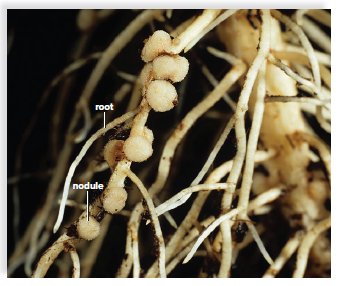
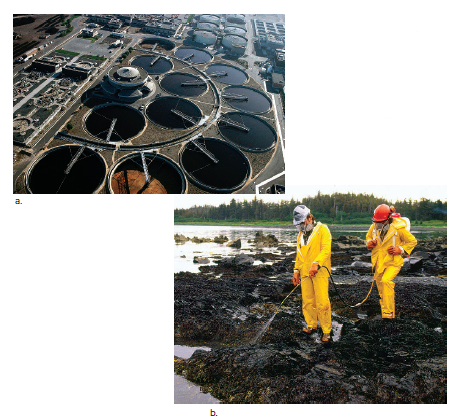
Bacteria in Food Science and Biotechnology
Bacteria can create a wide variety of food products through fermentation under anaerobic conditions.
Fermentation results in the production of various acids, including lactate, which is responsible for the tangy flavor in foods like pickles and cheese.
Other bacterial fermentations can produce flavor compounds, such as propionic acid in Swiss cheese.
Bacterial fermentation is useful in the production of vitamins and antibiotics, with most antibiotics discovered in soil bacteria.
Biotechnology can be used to genetically engineer bacteria to produce medically important products like insulin, human growth hormone, antibiotics, and vaccines.
Biotechnology can enhance the natural ability of bacteria to perform various reactions.

Bacterial Diseases in Humans
Microbes that cause disease are called pathogens.
Pathogens can produce toxins, adhere to surfaces, and invade organs or cells.
Toxins are small organic molecules, small pieces of protein, or parts of the bacterial cell wall that are released when bacteria die.
Adhesion factors allow a pathogen to bind to certain cells, determining which organs or cells of the body will be its host.
Invasive mechanisms give a pathogen the ability to move through tissues and into the bloodstream, resulting in a more medically significant disease.
Some bacteria in our bodies may cause long-term health problems by altering the metabolism of compounds in our food, causing health problems indirectly.
Antibiotics are used to treat medical conditions associated with bacteria.
Antibiotics need to target differences between prokaryotic bacterial cells and eukaryotic cells in our bodies.
Antibiotics target cell walls of bacteria or prokaryotic-specific enzymes involved in protein and DNA synthesis.
Overuse of antibiotics in medicine and agriculture has led to increasing bacterial resistance to antibiotics.
Archaea
Section 16.3 explains the organization of the Tree of Life into three domains: Archaea, Bacteria, and Eukarya.
Archaea and some bacteria are found in extreme environments, suggesting they may have diverged from a common ancestor soon after life began.
Eukarya are believed to have split off from the archaeal line of descent later.
Archaea and Eukarya share some ribosomal proteins not found in bacteria.
Archaea and Eukarya initiate transcription in the same manner.
Archaea and Eukarya have similar types of tRNA.
Structure of the Archaea
Archaea have plasma membranes that contain unusual lipids.
These lipids allow many archaea to function at high temperatures.
Archaea have diverse types of cell walls.
Cell walls of archaea do not contain peptidoglycan, unlike bacteria.
Some archaea have cell walls composed of polysaccharides.
Others have cell walls made of pure protein.
A few archaea have no cell wall at all.
Types of Archaea
Archaea are discussed in terms of their unique habitats.
Methanogens are found in anaerobic environments such as swamps, marshes, and animal intestines.
Methanogens are chemoautotrophs that produce methane from hydrogen gas and carbon dioxide to form ATP.
Methane produced by methanogenic archaea contributes to the greenhouse effect and global warming.
Halophiles require high-salt concentrations for growth and have been isolated from highly saline environments.
Halophiles depend on pigments related to rhodopsin in our eyes to absorb light energy for pumping chloride and synthesizing ATP.
Thermoacidophiles are isolated from extremely hot, acidic environments such as hot springs, geysers, and submarine thermal vents.
Thermoacidophiles reduce sulfur to sulfides and grow best at temperatures above 80°C and pH 1 to 2.
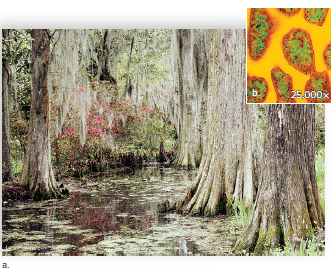
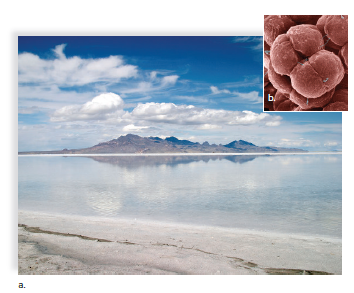
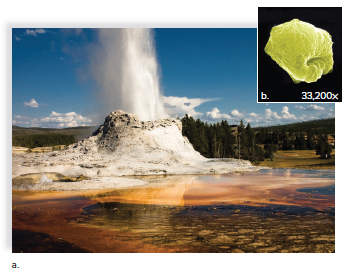
17.4 The Protists
Protists inhabit oceans and watery environments.
Protists have morphological diversity.
Diatoms are single-celled and encrusted in silica "petri dishes."
Dinoflagellates have plates of armor.
Ciliates are shaped like slippers.
Evolution of Protists
Many protists are single-celled, but all are eukaryotes with a nucleus and a wide range of organelles.
The organelles of eukaryotic cells arose from close symbiotic associations between bacteria and primitive eukaryotes.
The endosymbiotic theory is supported by the presence of double membranes around mitochondria and chloroplasts.
Mitochondria appear closely related to certain bacteria, and chloroplasts are most closely related to cyanobacteria.
Some single-celled protists have organelles not seen in other eukaryotes, such as food vacuoles and contractile vacuoles.
Protists possibly give us insight into the evolution of a multicellular organism with differentiated tissues.
Some protists take the form of a colony of single cells, with certain cells specialized in producing eggs and sperm; others are multicellular, with tissues specialized for various purposes.
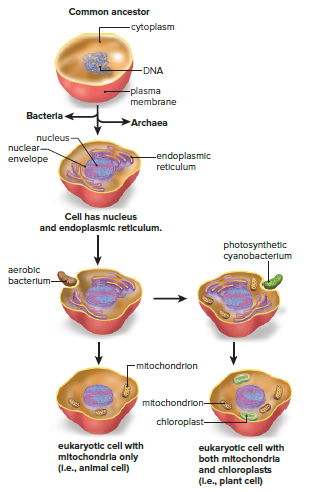
Classification of Protists
Many classification schemes have been created to define relationships between protists.
Protists can have unique characteristics that make them difficult to classify.
Traditionally, protists were classified based on their source of energy and nutrients.
Algae are photosynthetic, protozoans are heterotrophic by ingestion, and water molds and slime molds are heterotrophic by absorption.
Newer data, such as gene-sequencing information, has resulted in controversy and the formation of supergroups to classify eukaryotes.
There are currently five supergroups that represent separate evolutionary lineages.
Advances in DNA technology, such as genome sequencing, provide new information on supergroup relationships.
A simplified diagram of supergroup relationships is shown in Figure 17.20.
The supergroup level of classification is used to understand the diversity of protists.
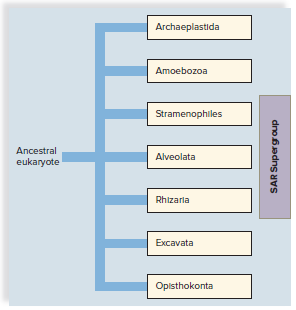
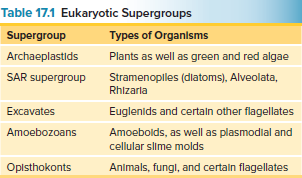
The Archaeplastids
Archaeplastids include land plants and green and red algae.
Chloroplasts in archaeplastids are derived from endosymbiotic cyanobacteria.
Algae are photosynthetic organisms that can be found in aquatic and terrestrial environments.
Algae are producers and a source of food for other organisms.
Algae can partner with fungi in lichens and with animals like corals.
Algae are classified based on the color of their pigments in chloroplasts: green, red, and brown.
Green algae are most closely related to plants and have three common species: Chlamydomonas, colonial Volvox, and Spirogyra.
Algae have chloroplasts, pyrenoids, vacuoles, mitochondria, and cell walls.
Algae can reproduce asexually or sexually, with sexual reproduction requiring the formation of gametes that combine to form a zygote.
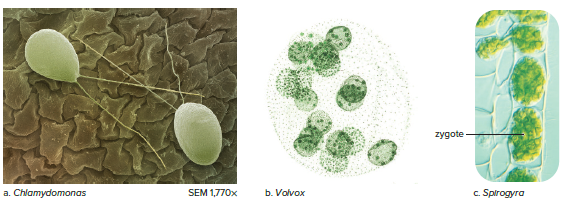

The SAR Supergroup
Researchers are studying the evolutionary relationships between some protists.
Genomic analyses suggest that stramenopiles, alveolates, and rhizarians are closely related to each other and form the SAR supergroup.
Stramenopiles are a diverse group of protists that include photosynthetic algae and diatoms.
Brown algae are multicellular seaweeds that dominate rocky shores along cold and temperate coasts. They have a slimy matrix called algin that is used in various products.
Diatoms are single-celled organisms with an ornate silica shell. They make up a significant part of plankton and serve as a source of oxygen and food for heterotrophs in both freshwater and marine ecosystems.
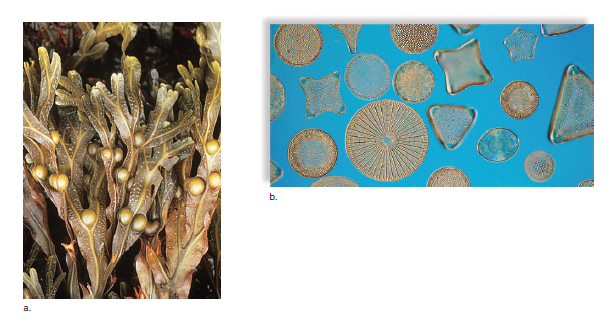
Alveolates are a diverse group of single-celled protists.
They have an internal series of cavities that support the plasma membrane.
Examples of alveolates include apicomplexans, dinoflagellates, and ciliates.
Apicomplexans are not motile and produce spores.
Plasmodium, a genus of apicomplexans, causes malaria.
Dinoflagellates are known for causing red tides and produce a potent toxin that accumulates in shellfish.
Ciliates are one of the largest groups of animal-like protists and have cilia that help capture prey and particles of food.
Paramecium is the most widely known ciliate and is commonly used for research and teaching.
Rhizarians are all amoeba-like organisms that generally produce external shells.
Foraminifera are marine organisms that produce a hard external shell called a test.
Radiolarians are marine organisms that produce intricate mineral-rich outer shells, and some form symbiotic relationships with algae.

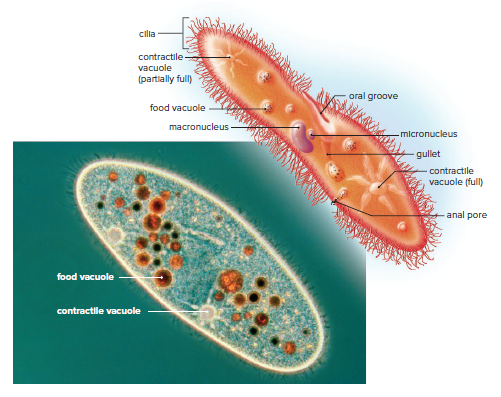
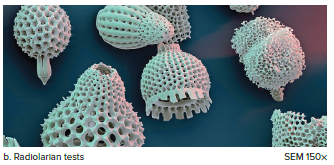
The Excavata
Supergroup Excavata:
Often lack mitochondria.
Possess distinctive flagella and/or deep (excavated) oral grooves.
Historically referred to as flagellates.
Euglenozoa:
Freshwater single-celled organisms.
Many have chloroplasts, but some do not.
Those that lack chloroplasts ingest or absorb their food.
Those that have chloroplasts acquired them by ingestion and subsequent endosymbiosis of a green algal cell.
Euglenids have two flagella, one of which is typically much longer than the other and projects out of the anterior, vase-shaped invagination.
Near the base of this flagellum is an eyespot, which is a photoreceptive organelle for detecting light.
Genus Giardia:
Two nuclei and multiple flagella.
Do not possess the mitochondria and Golgi apparatus common to most eukaryotes.
Giardia lamblia (or G. intestinalis) is a parasite of the intestinal tract of many animals, including humans.
Commonly spreads via drinking water that has been contaminated by the feces of an infected animal, although it is possible to contract Giardia from the soil or food.
Symptoms of giardiasis include diarrhea, stomach and/or intestinal cramping, and excess gas (flatulence.)
For most people, a Giardia infection lasts several weeks, but the parasite has been known to cause complications in the elderly, young children, and individuals with compromised immune systems.
Antibiotics are ineffective, although other medications are available.
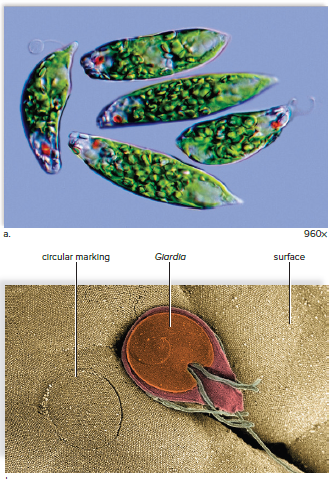
The Amoebozoa
Amoebozoa are protists that move by pseudopods.
They live in aquatic environments such as oceans and freshwater lakes and ponds.
They feed on algae, bacteria, or other protists by engulfing them with their pseudopods.
Digestion occurs within a food vacuole.
Amoeba proteus is an example of Amoebozoa and is frequently used in science labs due to its large size.
Slime molds are another type of Amoebozoa and are chemoheterotrophs.
They feed on dead plant material and bacteria in forests and woodlands.
Plasmodial slime molds exist as a diploid, multinucleated, cytoplasmic mass enveloped by a slime sheath that creeps along, phagocytizing decaying plant material.
During unfavorable growth conditions, the plasmodium develops many sporangia, which are reproductive structures that produce spores resistant to dry conditions.
When favorable moist conditions return, the spores germinate, releasing a flagellated cell or an amoeboid cell.
Two of these cells fuse to form a zygote that feeds and grows, developing into a multinucleated plasmodium again.
Figure 17.29 shows the life cycle of a plasmodial slime mold.
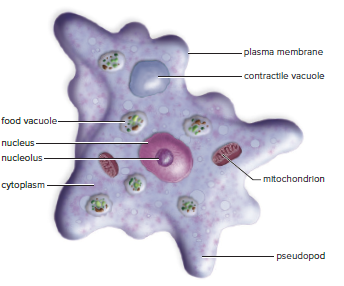
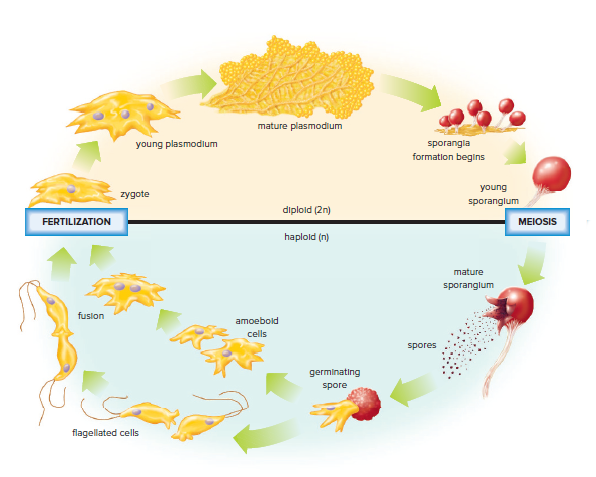
The Opisthokonta
Supergroup Opisthokonta contains animals, fungi, and several closely related protists.
All organisms in this group are chemoheterotrophs with flagellated cells.
This supergroup includes both single-celled and multicellular protozoans.
Among the opisthokonts are the choanoflagellates, animal-like protozoans that are closely related to sponges.
Choanoflagellates are filter feeders with cells that bear a striking resemblance to the choanocytes that line the insides of sponges.
Each choanoflagellate has a single posterior flagellum surrounded by a collar of slender microvilli.
The beating of the flagellum creates a water current that flows through the collar, where food particles are taken in by phagocytosis.
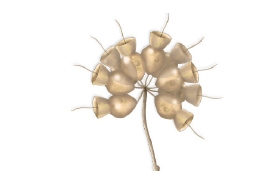
Chapter 17: The Microorganisms Viruses, Bacteria, and Protists
17.1 The Viruses
Viruses have not been classified as living historically.
The classification of viruses as living or not is still debated among biologists.
Viruses possess a genome consisting of a few hundred genes.
Viruses use the host cell to manufacture new viruses.
The origins of viruses are unclear.
Some research suggests that viruses may be remnants of bacteria.
Viruses have played an important role in the evolution of life on the planet.
The debate over whether viruses are living or not continues in the scientific community.
Structure of a Virus
Each type of virus has at least two parts: an outer capsid and an inner core.
The outer capsid is composed of protein subunits.
The inner core contains genetic material, which may be DNA or RNA.
The influenza virus has spikes formed from a glycoprotein, which are involved in attaching the virus to the host cell.
Influenza viruses have two types of spikes, and the variations in their structure give each type of influenza virus its name.
Some viruses that attack animals have an outer membranous envelope with glycoprotein spikes.
The envelope is a piece of the host's plasma membrane, which also contains proteins produced by the virus.
The interior of a virus can contain various enzymes that assist in the manufacture of new viruses.
The viral genome may be either DNA or RNA, but it has at most several hundred genes, while a human cell contains around 23,000 genes.

Viral Reproduction
Viruses need to attach to a specific molecule called a receptor on the host cell's outer surface to infect it.
The attachment is in a lock-and-key manner, where a spike or some portion of the capsid adheres to the receptor.
A virus cannot infect a host cell if it is unable to attach to it.
The tobacco mosaic virus cannot infect humans because its capsid cannot attach to the receptors on human cells.
Once inside a host cell, the virus takes over the metabolic machinery of the host cell.
The virus uses the host's enzymes, ribosomes, transfer RNA (tRNA), and ATP to reproduce itself.
Reproduction of Bacteriophages
A bacteriophage is a virus that reproduces in a bacterium.
Phages are often used as model systems for the study of viral reproduction.
Phage lambda (λ) is a type of bacteriophage.
Phage λ can reproduce via the lytic cycle or the lysogenic cycle.
The lytic cycle has five stages: attachment, penetration, biosynthesis, maturation, and release.
During attachment, the capsid combines with a receptor in the bacterial cell wall.
During penetration, a viral enzyme digests away part of the cell wall, and viral DNA is injected into the bacterial cell.
Biosynthesis of viral components begins after the virus inactivates host genes not necessary for viral replication.
During maturation, viral DNA and capsids assemble to produce several hundred viral particles.
Lysozyme, an enzyme coded for by a viral gene, disrupts the cell wall, and the release of phage particles occurs.
The lysogenic cycle involves the infected bacterium not immediately producing phages.
Following attachment and penetration, integration occurs: Viral DNA becomes incorporated into bacterial DNA with no destruction of host DNA.
While latent, the viral DNA is called a prophage.
The prophage is replicated along with the host DNA, and all subsequent cells, called lysogenic cells, carry a copy of the prophage.
Certain environmental factors, such as ultraviolet radiation, can induce the prophage to enter the lytic stage of biosynthesis, followed by maturation and release.

Plant Viruses
Crops and garden plants can be infected by viruses.
Plant viruses enter through damaged tissues and move through plasmodesmata.
The tobacco mosaic virus is a well-studied plant virus with a long, rod-shaped structure.
Plant viruses can be transmitted by insects, gardening tools, seeds, and pollen.
Viral diseases cannot be controlled by chemicals.
Symptomatic plants must be destroyed and insect vectors controlled to deal with viral diseases.
Biotechnology and genetic engineering can transfer disease-resistant genes between plants.
Papaya plants resistant to papaya ring spot virus (PRSV) have been created in Hawaii using genetic engineering.
One transgenic line of papaya plants is now completely resistant to PRSV.

Animal Viruses
Viruses that cause disease in animals, including humans, reproduce similarly to bacteriophages.
Some animal viruses have an outer membranous envelope beyond their capsid.
Enveloped viruses either fuse with the plasma membrane or enter the host cell by endocytosis after attachment to a receptor in the plasma membrane.
The general life cycle of an animal virus involves uncoating, biosynthesis, maturation, and release.
Naked animal viruses exit the host cell in the same manner as bacteriophages, while animal viruses with an envelope bud from the cell.
Herpesviruses remain latent in the spinal ganglia until stimulated to undergo the lytic cycle.
HIV remains relatively latent in lymphocytes, slowly releasing new viruses.

Retroviruses
Retroviruses use RNA as their genetic material.
Retroviruses contain an enzyme called reverse transcriptase.
Reverse transcriptase transcribes RNA to DNA.
One strand of DNA is synthesized using viral RNA as a template.
A complementary DNA strand is synthesized.
The resulting double-stranded DNA is integrated into the host genome.
Viral DNA remains in the host genome and is replicated with host DNA.
When transcribed, new viruses are produced through biosynthesis, maturation, and release.
HIV is an animal virus with an envelope.
HIV buds from the cell.
Emerging Viruses
HIV is an emerging virus that causes a disease that has recently infected large numbers of people.
Other examples of emerging viruses include West Nile virus, SARS virus, hantavirus, and avian influenza (H5N1) virus.
Infectious diseases emerge in several different ways, including the transportation of the virus from one location to another.
West Nile virus is an emerging virus because it changed its range and was transported into the United States, taking hold in bird and mosquito populations.
SARS was transported from Asia to Toronto, Canada.
Viruses are well known for their high mutation rates, and some mutations affect the structure of the spikes or capsids, allowing a virus that previously infected only a particular animal species to infect humans.
Examples of this include the viruses that cause AIDS and Ebola fever, which at one time infected only monkeys and apes.
MERS is a coronavirus that causes respiratory problems like shortness of breath, coughing, and fever.
MERS is a novel class of coronavirus that was not previously detected in humans.
Wild ducks are resistant to avian influenza viruses that can spread from them to chickens.
This increases the likelihood of the disease spreading to humans.
H5N1 is a virus that may change its mode of transmission from contact to airborne, which could increase the number of people exposed to bird flu.

Drug Control of Human Viral Diseases
Antibiotics are ineffective against viruses as they only target living bacterial cells.
Viral infections were historically treated by allowing the immune system to use an adaptive immunity response.
Immunization is effective in preventing specific viral infections.
Antiviral drugs target specific aspects of the viral life cycle.
Antiviral compounds such as ribavirin and acyclovir interfere with viral genome synthesis.
Compounds related to acyclovir are used to suppress herpes outbreaks.
HIV is treated with antiviral compounds specific to the retrovirus.
AZT and other drugs block reverse transcriptase in HIV.
HIV protease inhibitors block enzymes required for viral protein maturation.
17.2 Viroids and Prions
About a dozen crop diseases are caused by viroids, which are naked RNA strands.
Viroids direct host cells to produce more viroids.
Viroids can cause unhealthy host plants and alter their physical characteristics.
Prions are proteinaceous infectious particles.
Prions cause kuru, a neurodegenerative disorder in a primitive tribe in Papua New Guinea.
Prions are smaller than viruses and are misshapen proteins.
Prions can interact with normal proteins, causing them to change shape and act as infectious agents.
Prion diseases include scrapie in sheep, mad cow disease, Creutzfeldt-Jakob disease in humans, and chronic wasting syndromes in other animal species.

17.3 The Prokaryotes
The study of prokaryotes provides answers to questions about the first life on Earth and the most primitive features in modern cells.
Prokaryotes are single-celled organisms that lack a nucleus and internal organelle structures found in eukaryotes.
Some prokaryotes have internal membranes that perform similar functions to organelles.
Prokaryotes can be metabolically complex and can survive in extreme environments.
Prokaryotes are one of the dominant life forms on Earth in terms of numbers and biomass.
The Origin of the First Cells
Until the 19th century, many believed that prokaryotes could arise spontaneously.
Louis Pasteur showed in 1850 that previously sterilized broth cannot become cloudy with growth unless it is exposed directly to the air where bacteria are abundant.
The cell theory formulated around this time states that all organisms are composed of cells, cells are capable of self-reproduction, and cells come only from preexisting cells.
The first living cells were prokaryotes, possessing DNA but lacking a nucleus.
Fossilized prokaryotes have been found in rocks that are 3.5 billion years old.
The first cells were preceded by biological macromolecules, such as proteins and nucleic acids.
Amino acids, nucleotides, and other building blocks for biological macromolecules are routinely produced by living cells; this process is known as biotic synthesis.
Prior to cellular life, macromolecules must have formed by abiotic synthesis.
Stanley Miller conducted an experiment in the 1950s that indicated it was possible to form amino acids under the conditions that existed on the early Earth.
Protocells, cell-like structures complete with an outer membrane, may have resulted from the self-assembly of macromolecules and eventually given rise to cellular life.
Some researchers think the first hereditary molecule may have been RNA.
Over time, the more stable DNA replaced RNA as a long-term repository for genetic information, leading to the self-replicating system seen in all living cells today.

Bacteria
Bacteria are the most diverse and prevalent organisms on Earth.
Billions of bacteria exist in nearly every square meter of soil, water, and air.
Bacteria also inhabit our skin and intestines.
Tens of thousands of different bacteria have been identified, but they likely represent only a small fraction of the total number of bacterial species on the planet.
Less than 1% of bacteria in the soil can be grown in the laboratory.
Molecular genetic techniques are being used to discover the extent of bacterial diversity.
General Biology of Bacteria
Bacteria have various shapes, including cocci (spheres), bacilli (rods), spirilla (rigid spirals), and spirochetes (flexible spirals).
Some variations in bacterial shape include vibrios (slightly curved rods), doublets, chains (such as streptococci), and bunches of grapes (such as staphylococci).
Bacteria lack a nucleus but have a single, closed circle of double-stranded DNA called the chromosome, which occurs in the nucleoid.
Bacterial cells may also contain extrachromosomal DNA molecules called plasmids.
Bacteria have ribosomes but lack membrane-bound organelles like mitochondria and chloroplasts.
Some bacteria have internal folds of membranes that contain enzymes for cellular functions, such as thylakoid membranes in photosynthetic bacteria.
Motile bacteria use flagella for locomotion, which have a filament composed of three strands of the protein flagellin wound in a helix and are anchored in the plasma membrane by a basal body.


Bacterial Structure
Bacteria have a variety of shapes, including cocci (spheres), bacilli (rods), spirilla (rigid spirals), and spirochetes (flexible spirals).
Some variations in bacterial shape include vibrios (slightly curved rods), doublets, chains, and bunches of grapes.
Bacteria have no nucleus, and a single, closed circle of double-stranded DNA constitutes the chromosome, which occurs in an area of the cell called the nucleoid.
Bacteria have ribosomes but not membrane-bound organelles, such as mitochondria and chloroplasts.
Some bacteria have internal folds of membranes, which contain enzymes for cellular functions.
Motile bacteria generally use flagella for locomotion, which is not structured like a eukaryotic flagellum.
Bacterial Reproduction
Bacteria reproduce asexually by binary fission.
The single, circular chromosome replicates, and then the two copies separate as the cell enlarges.
The newly formed plasma membrane and cell wall partition the two new cells, with a chromosome in each one.
Mitosis does not occur in prokaryotes.
Eukaryotes undergo genetic recombination through sexual reproduction.
Prokaryotes do not undergo sexual reproduction.
Three means of genetic recombination have been observed in bacteria.
Conjugation is one of the three means of genetic recombination in bacteria.
During conjugation, a donor cell passes DNA directly to a recipient cell.
The donor and recipient cells are temporarily linked together during conjugation.
The conjugation pilus is often used to link the donor and recipient cells.
DNA is passed from the donor cell to the recipient cell while they are linked.
Transformation: Bacteria can take up free DNA from the environment. This DNA can come from dead bacteria or from other living bacteria.
Transduction: Bacteriophages, which are viruses that infect bacteria, can carry portions of bacterial DNA from one cell to another.
Endospores: Under unfavorable environmental conditions, some bacteria can form endospores. Endospores are dormant, highly resistant structures that can survive harsh conditions for extended periods of time. When conditions improve, endospores can germinate and produce new bacteria.

Prokaryotes are more metabolically diverse than eukaryotes.
Plants are photoautotrophs that perform oxygenic photosynthesis.
Cyanobacteria are an example of photosynthetic bacteria and may represent the oldest lineage of oxygenic organisms.
Cyanobacteria drastically altered the atmosphere of the early Earth by adding vast amounts of oxygen.
Many cyanobacteria are capable of fixing atmospheric nitrogen and reducing it to an organic form.
Other bacterial photosynthesizers don’t release oxygen because they take electrons from a source other than water.
Chemoautotrophs don’t use solar energy at all and reduce carbon dioxide using energetic electrons derived from inorganic molecules.
Most bacteria are chemoheterotrophs that take in organic nutrients, which they use as a source of energy and as building blocks to synthesize macromolecules.
Chemoheterotrophic bacteria are saprotrophs that send enzymes into the environment and decompose almost any large organic molecule into smaller ones that are absorbable.
Bacteria play a critical role in recycling matter and making inorganic molecules available to photosynthesizers.
Heterotrophic bacteria can be free-living or symbiotic.
Symbiotic relationships can be mutualistic, commensalistic, or parasitic.
Mutualistic bacteria in human intestines release vitamins K and B12.
Mutualistic prokaryotes in cow and goat stomachs digest cellulose.
Commensalism occurs when one population modifies the environment for the benefit of another.
Obligate anaerobes can live in our intestines because E. coli uses up oxygen.
Parasitic bacteria cause diseases.

Environmental and Medical Importance of Bacteria
Bacteria play a crucial role in the cycling of elements in an ecosystem.
They are decomposers that digest dead organic remains and return inorganic nutrients to producers.
Bacteria perform the reactions needed for biogeochemical cyclings, such as for the carbon and nitrogen cycles.
Plants are unable to fix atmospheric nitrogen, but bacteria in the soil can fix atmospheric nitrogen and/or change nitrogen compounds into forms that plants can use.
Mutualistic bacteria live in the root nodules of soybean, clover, and alfalfa plants, where they reduce atmospheric nitrogen to ammonia, which is used by plants.
Bioremediation is the biological cleanup of an environment that contains harmful chemicals called pollutants.
Bacteria are being exploited to break down almost any substance, including sewage, pesticides, herbicides, detergents, and plastics.
Strains of bacteria are being developed specifically for digesting these types of pollutants.
Genetically modified bacteria can break the carbon-carbon bonds within oil spills, but their effectiveness is based on weather conditions and the availability of certain nutrients.


Bacteria in Food Science and Biotechnology
Bacteria can create a wide variety of food products through fermentation under anaerobic conditions.
Fermentation results in the production of various acids, including lactate, which is responsible for the tangy flavor in foods like pickles and cheese.
Other bacterial fermentations can produce flavor compounds, such as propionic acid in Swiss cheese.
Bacterial fermentation is useful in the production of vitamins and antibiotics, with most antibiotics discovered in soil bacteria.
Biotechnology can be used to genetically engineer bacteria to produce medically important products like insulin, human growth hormone, antibiotics, and vaccines.
Biotechnology can enhance the natural ability of bacteria to perform various reactions.

Bacterial Diseases in Humans
Microbes that cause disease are called pathogens.
Pathogens can produce toxins, adhere to surfaces, and invade organs or cells.
Toxins are small organic molecules, small pieces of protein, or parts of the bacterial cell wall that are released when bacteria die.
Adhesion factors allow a pathogen to bind to certain cells, determining which organs or cells of the body will be its host.
Invasive mechanisms give a pathogen the ability to move through tissues and into the bloodstream, resulting in a more medically significant disease.
Some bacteria in our bodies may cause long-term health problems by altering the metabolism of compounds in our food, causing health problems indirectly.
Antibiotics are used to treat medical conditions associated with bacteria.
Antibiotics need to target differences between prokaryotic bacterial cells and eukaryotic cells in our bodies.
Antibiotics target cell walls of bacteria or prokaryotic-specific enzymes involved in protein and DNA synthesis.
Overuse of antibiotics in medicine and agriculture has led to increasing bacterial resistance to antibiotics.
Archaea
Section 16.3 explains the organization of the Tree of Life into three domains: Archaea, Bacteria, and Eukarya.
Archaea and some bacteria are found in extreme environments, suggesting they may have diverged from a common ancestor soon after life began.
Eukarya are believed to have split off from the archaeal line of descent later.
Archaea and Eukarya share some ribosomal proteins not found in bacteria.
Archaea and Eukarya initiate transcription in the same manner.
Archaea and Eukarya have similar types of tRNA.
Structure of the Archaea
Archaea have plasma membranes that contain unusual lipids.
These lipids allow many archaea to function at high temperatures.
Archaea have diverse types of cell walls.
Cell walls of archaea do not contain peptidoglycan, unlike bacteria.
Some archaea have cell walls composed of polysaccharides.
Others have cell walls made of pure protein.
A few archaea have no cell wall at all.
Types of Archaea
Archaea are discussed in terms of their unique habitats.
Methanogens are found in anaerobic environments such as swamps, marshes, and animal intestines.
Methanogens are chemoautotrophs that produce methane from hydrogen gas and carbon dioxide to form ATP.
Methane produced by methanogenic archaea contributes to the greenhouse effect and global warming.
Halophiles require high-salt concentrations for growth and have been isolated from highly saline environments.
Halophiles depend on pigments related to rhodopsin in our eyes to absorb light energy for pumping chloride and synthesizing ATP.
Thermoacidophiles are isolated from extremely hot, acidic environments such as hot springs, geysers, and submarine thermal vents.
Thermoacidophiles reduce sulfur to sulfides and grow best at temperatures above 80°C and pH 1 to 2.



17.4 The Protists
Protists inhabit oceans and watery environments.
Protists have morphological diversity.
Diatoms are single-celled and encrusted in silica "petri dishes."
Dinoflagellates have plates of armor.
Ciliates are shaped like slippers.
Evolution of Protists
Many protists are single-celled, but all are eukaryotes with a nucleus and a wide range of organelles.
The organelles of eukaryotic cells arose from close symbiotic associations between bacteria and primitive eukaryotes.
The endosymbiotic theory is supported by the presence of double membranes around mitochondria and chloroplasts.
Mitochondria appear closely related to certain bacteria, and chloroplasts are most closely related to cyanobacteria.
Some single-celled protists have organelles not seen in other eukaryotes, such as food vacuoles and contractile vacuoles.
Protists possibly give us insight into the evolution of a multicellular organism with differentiated tissues.
Some protists take the form of a colony of single cells, with certain cells specialized in producing eggs and sperm; others are multicellular, with tissues specialized for various purposes.

Classification of Protists
Many classification schemes have been created to define relationships between protists.
Protists can have unique characteristics that make them difficult to classify.
Traditionally, protists were classified based on their source of energy and nutrients.
Algae are photosynthetic, protozoans are heterotrophic by ingestion, and water molds and slime molds are heterotrophic by absorption.
Newer data, such as gene-sequencing information, has resulted in controversy and the formation of supergroups to classify eukaryotes.
There are currently five supergroups that represent separate evolutionary lineages.
Advances in DNA technology, such as genome sequencing, provide new information on supergroup relationships.
A simplified diagram of supergroup relationships is shown in Figure 17.20.
The supergroup level of classification is used to understand the diversity of protists.


The Archaeplastids
Archaeplastids include land plants and green and red algae.
Chloroplasts in archaeplastids are derived from endosymbiotic cyanobacteria.
Algae are photosynthetic organisms that can be found in aquatic and terrestrial environments.
Algae are producers and a source of food for other organisms.
Algae can partner with fungi in lichens and with animals like corals.
Algae are classified based on the color of their pigments in chloroplasts: green, red, and brown.
Green algae are most closely related to plants and have three common species: Chlamydomonas, colonial Volvox, and Spirogyra.
Algae have chloroplasts, pyrenoids, vacuoles, mitochondria, and cell walls.
Algae can reproduce asexually or sexually, with sexual reproduction requiring the formation of gametes that combine to form a zygote.


The SAR Supergroup
Researchers are studying the evolutionary relationships between some protists.
Genomic analyses suggest that stramenopiles, alveolates, and rhizarians are closely related to each other and form the SAR supergroup.
Stramenopiles are a diverse group of protists that include photosynthetic algae and diatoms.
Brown algae are multicellular seaweeds that dominate rocky shores along cold and temperate coasts. They have a slimy matrix called algin that is used in various products.
Diatoms are single-celled organisms with an ornate silica shell. They make up a significant part of plankton and serve as a source of oxygen and food for heterotrophs in both freshwater and marine ecosystems.

Alveolates are a diverse group of single-celled protists.
They have an internal series of cavities that support the plasma membrane.
Examples of alveolates include apicomplexans, dinoflagellates, and ciliates.
Apicomplexans are not motile and produce spores.
Plasmodium, a genus of apicomplexans, causes malaria.
Dinoflagellates are known for causing red tides and produce a potent toxin that accumulates in shellfish.
Ciliates are one of the largest groups of animal-like protists and have cilia that help capture prey and particles of food.
Paramecium is the most widely known ciliate and is commonly used for research and teaching.
Rhizarians are all amoeba-like organisms that generally produce external shells.
Foraminifera are marine organisms that produce a hard external shell called a test.
Radiolarians are marine organisms that produce intricate mineral-rich outer shells, and some form symbiotic relationships with algae.



The Excavata
Supergroup Excavata:
Often lack mitochondria.
Possess distinctive flagella and/or deep (excavated) oral grooves.
Historically referred to as flagellates.
Euglenozoa:
Freshwater single-celled organisms.
Many have chloroplasts, but some do not.
Those that lack chloroplasts ingest or absorb their food.
Those that have chloroplasts acquired them by ingestion and subsequent endosymbiosis of a green algal cell.
Euglenids have two flagella, one of which is typically much longer than the other and projects out of the anterior, vase-shaped invagination.
Near the base of this flagellum is an eyespot, which is a photoreceptive organelle for detecting light.
Genus Giardia:
Two nuclei and multiple flagella.
Do not possess the mitochondria and Golgi apparatus common to most eukaryotes.
Giardia lamblia (or G. intestinalis) is a parasite of the intestinal tract of many animals, including humans.
Commonly spreads via drinking water that has been contaminated by the feces of an infected animal, although it is possible to contract Giardia from the soil or food.
Symptoms of giardiasis include diarrhea, stomach and/or intestinal cramping, and excess gas (flatulence.)
For most people, a Giardia infection lasts several weeks, but the parasite has been known to cause complications in the elderly, young children, and individuals with compromised immune systems.
Antibiotics are ineffective, although other medications are available.

The Amoebozoa
Amoebozoa are protists that move by pseudopods.
They live in aquatic environments such as oceans and freshwater lakes and ponds.
They feed on algae, bacteria, or other protists by engulfing them with their pseudopods.
Digestion occurs within a food vacuole.
Amoeba proteus is an example of Amoebozoa and is frequently used in science labs due to its large size.
Slime molds are another type of Amoebozoa and are chemoheterotrophs.
They feed on dead plant material and bacteria in forests and woodlands.
Plasmodial slime molds exist as a diploid, multinucleated, cytoplasmic mass enveloped by a slime sheath that creeps along, phagocytizing decaying plant material.
During unfavorable growth conditions, the plasmodium develops many sporangia, which are reproductive structures that produce spores resistant to dry conditions.
When favorable moist conditions return, the spores germinate, releasing a flagellated cell or an amoeboid cell.
Two of these cells fuse to form a zygote that feeds and grows, developing into a multinucleated plasmodium again.
Figure 17.29 shows the life cycle of a plasmodial slime mold.


The Opisthokonta
Supergroup Opisthokonta contains animals, fungi, and several closely related protists.
All organisms in this group are chemoheterotrophs with flagellated cells.
This supergroup includes both single-celled and multicellular protozoans.
Among the opisthokonts are the choanoflagellates, animal-like protozoans that are closely related to sponges.
Choanoflagellates are filter feeders with cells that bear a striking resemblance to the choanocytes that line the insides of sponges.
Each choanoflagellate has a single posterior flagellum surrounded by a collar of slender microvilli.
The beating of the flagellum creates a water current that flows through the collar, where food particles are taken in by phagocytosis.

 Knowt
Knowt